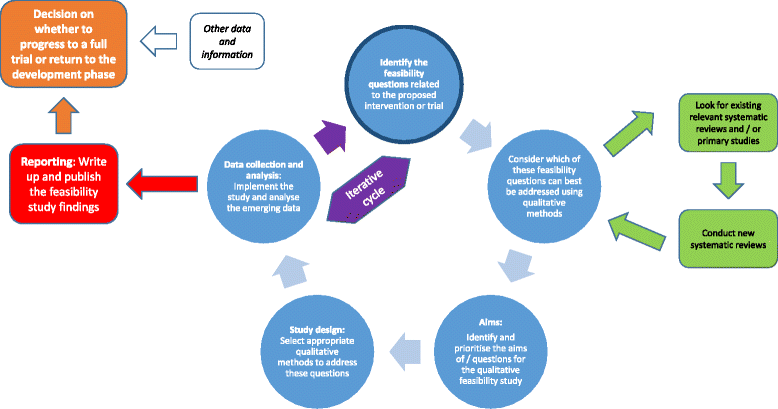Maximising the impact of qualitative research in feasibility studies for randomised controlled trials: guidance for researchers
- PMID: 27965810
- PMCID: PMC5154038
- DOI: 10.1186/s40814-015-0026-y
Maximising the impact of qualitative research in feasibility studies for randomised controlled trials: guidance for researchers
Abstract
Feasibility studies are increasingly undertaken in preparation for randomised controlled trials in order to explore uncertainties and enable trialists to optimise the intervention or the conduct of the trial. Qualitative research can be used to examine and address key uncertainties prior to a full trial. We present guidance that researchers, research funders and reviewers may wish to consider when assessing or undertaking qualitative research within feasibility studies for randomised controlled trials. The guidance consists of 16 items within five domains: research questions, data collection, analysis, teamwork and reporting. Appropriate and well conducted qualitative research can make an important contribution to feasibility studies for randomised controlled trials. This guidance may help researchers to consider the full range of contributions that qualitative research can make in relation to their particular trial. The guidance may also help researchers and others to reflect on the utility of such qualitative research in practice, so that trial teams can decide when and how best to use these approaches in future studies.
Keywords: Feasibility studies; Guidance; Pilot studies; Qualitative methods; Randomised controlled trial.
Figures
Similar articles
-
Maximising the value of combining qualitative research and randomised controlled trials in health research: the QUAlitative Research in Trials (QUART) study--a mixed methods study.Health Technol Assess. 2014 Jun;18(38):1-197, v-vi. doi: 10.3310/hta18380. Health Technol Assess. 2014. PMID: 24914457 Free PMC article.
-
The future of Cochrane Neonatal.Early Hum Dev. 2020 Nov;150:105191. doi: 10.1016/j.earlhumdev.2020.105191. Epub 2020 Sep 12. Early Hum Dev. 2020. PMID: 33036834
-
Describing qualitative research undertaken with randomised controlled trials in grant proposals: a documentary analysis.BMC Med Res Methodol. 2014 Feb 18;14:24. doi: 10.1186/1471-2288-14-24. BMC Med Res Methodol. 2014. PMID: 24533771 Free PMC article.
-
Electronic self-reporting of adverse events for patients undergoing cancer treatment: the eRAPID research programme including two RCTs.Southampton (UK): NIHR Journals Library; 2022 Feb. Southampton (UK): NIHR Journals Library; 2022 Feb. PMID: 35138783 Free Books & Documents. Review.
-
Factors that impact on recruitment to randomised trials in health care: a qualitative evidence synthesis.Cochrane Database Syst Rev. 2020 Oct 7;10(10):MR000045. doi: 10.1002/14651858.MR000045.pub2. Cochrane Database Syst Rev. 2020. PMID: 33026107 Free PMC article.
Cited by
-
Exploring the Feasibility of Virtually Delivered Auricular Point Acupressure in Self-Managing Chronic Pain: Qualitative Study.Evid Based Complement Alternat Med. 2022 Aug 29;2022:8079691. doi: 10.1155/2022/8079691. eCollection 2022. Evid Based Complement Alternat Med. 2022. PMID: 36072397 Free PMC article.
-
"Who to Tell, How and When?": Development and Preliminary Feasibility of an Empowerment Intervention for People Living with Dementia Who are Fearful of Disclosing Their Diagnosis.Clin Interv Aging. 2020 Aug 14;15:1393-1407. doi: 10.2147/CIA.S257317. eCollection 2020. Clin Interv Aging. 2020. PMID: 32884249 Free PMC article.
-
A qualitative process evaluation of universal free school meal provision in two London secondary schools.BMC Public Health. 2023 Feb 9;23(1):300. doi: 10.1186/s12889-023-15082-3. BMC Public Health. 2023. PMID: 36759797 Free PMC article.
-
Clinical pharmacists' intervention on pain management in cancer patients (PharmaCAP trial): study protocol for a randomized controlled trial.J Pharm Policy Pract. 2023 Jan 24;16(1):14. doi: 10.1186/s40545-022-00505-0. J Pharm Policy Pract. 2023. PMID: 36694232 Free PMC article.
-
Independent prescribing by advanced physiotherapists for patients with low back pain in primary care: protocol for a feasibility trial with an embedded qualitative component.BMJ Open. 2019 May 1;9(4):e027745. doi: 10.1136/bmjopen-2018-027745. BMJ Open. 2019. PMID: 31048447 Free PMC article.
References
Publication types
Grants and funding
LinkOut - more resources
Full Text Sources
Other Literature Sources
Medical


